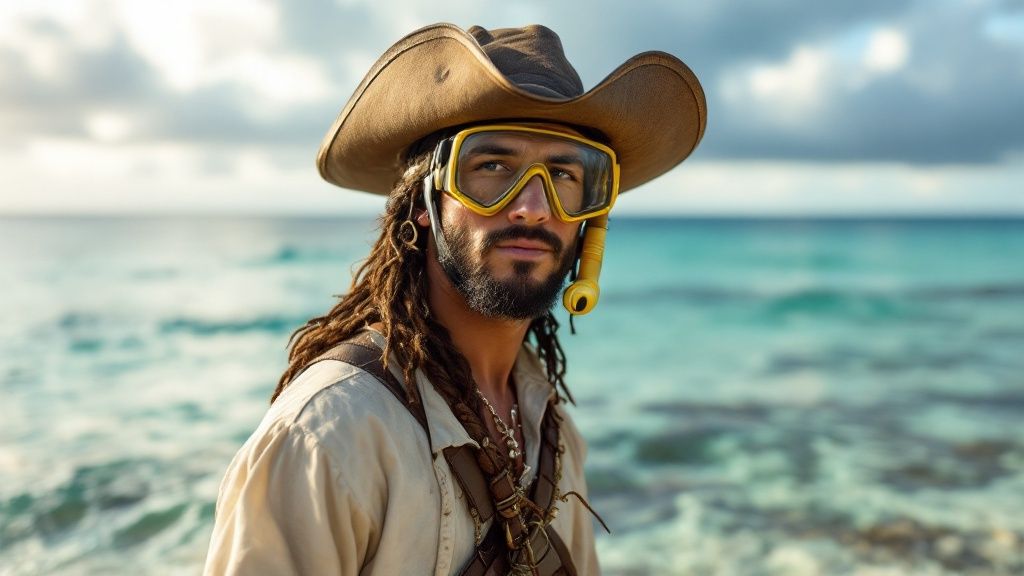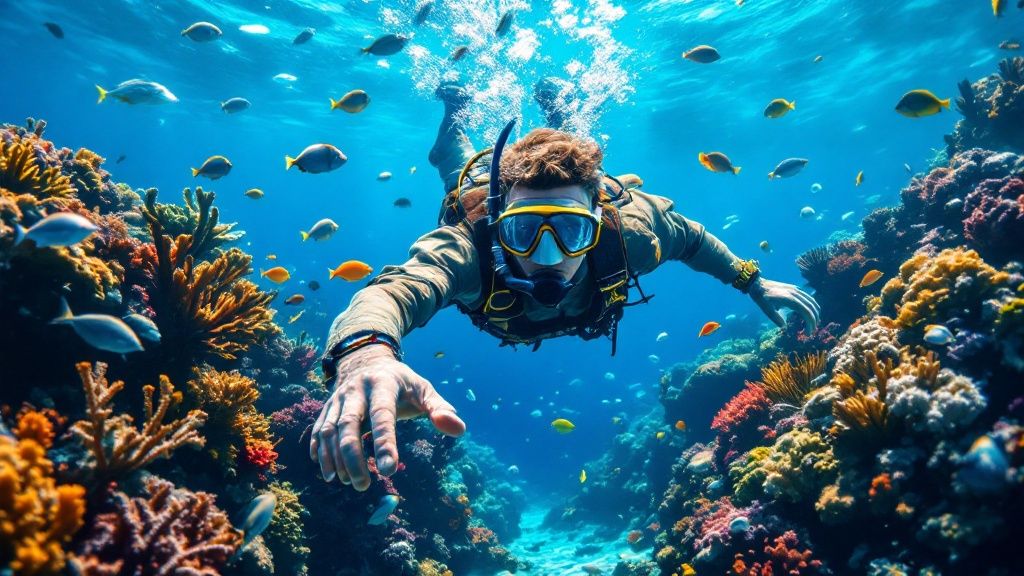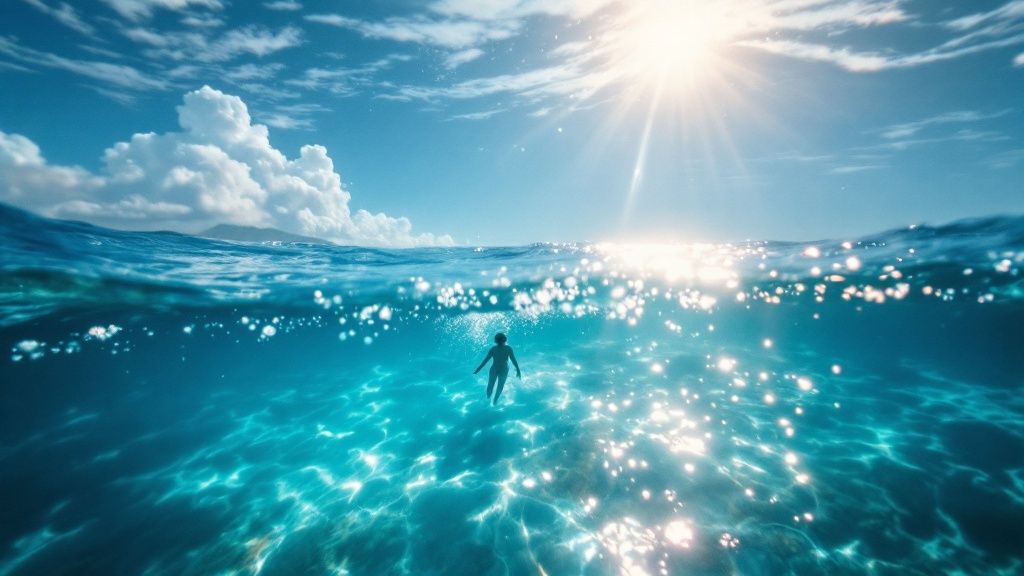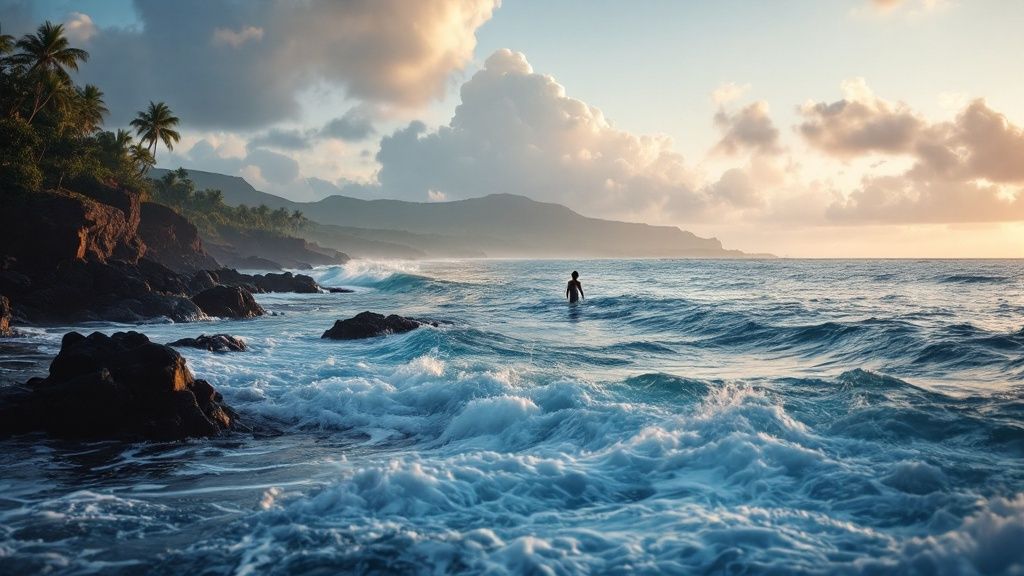Captain Cook Snorkeling Big Island - Adventure Guide
- Kona Snorkel Trips
- Mar 25
- 12 min read
Unlocking the Underwater Wonders of Captain Cook

Captain Cook snorkeling on the Big Island is an unforgettable experience. It’s a journey into a vibrant underwater world teeming with life and steeped in history. This isn't just any snorkeling spot; it's a unique look into a thriving ecosystem within one of Hawaii's most treasured marine sanctuaries.
Exceptional Visibility and a Thriving Ecosystem
Kealakekua Bay, home to the Captain Cook monument, boasts incredible visibility, often exceeding 100 feet. This exceptional clarity allows snorkelers to fully appreciate the vibrant coral reefs below. The protected status of the bay plays a vital role in maintaining this remarkable visibility.
Designated a Marine Life Conservation District since 1969, Kealakekua Bay has flourished. It now boasts one of Hawaii’s healthiest coral ecosystems.
Ideal Conditions for Marine Life
The thriving marine life in Captain Cook is due to a combination of factors. The sheltered geography of the bay creates calm, clear waters, perfect for coral growth and excellent visibility.
The complex reef structures provide a diverse habitat for various species. This ensures each snorkeling adventure has the potential for unique encounters. From colorful reef fish to graceful sea turtles, Captain Cook's biodiversity consistently impresses even experienced snorkelers.
A Place of Historical and Ecological Significance
The Captain Cook Monument at Kealakekua Bay holds both historical and ecological significance. It marks the spot where Captain James Cook was killed on February 14, 1779.
Encompassing approximately 315 acres, this bay attracts thousands of tourists annually. Visitors are drawn to its vibrant coral reefs and the diverse marine life. The bay offers an exceptional snorkeling experience, with visibility of up to 100 feet, allowing for exploration of the untouched coral and encounters with marine animals like sea turtles and spinner dolphins. Snorkeling tours, starting around $158 for adults, provide an immersive experience of the bay’s natural wonders. Learn more about the history and ecology of Kealakekua Bay here. You can also explore our blog categories for more information.
More Than Just Snorkeling
What truly sets Captain Cook snorkeling apart is its unique blend of natural beauty and historical significance. Snorkeling here isn’t just about observing marine life. It’s about connecting with a place rich in both ecological and cultural heritage.
The underwater world at Captain Cook provides a truly immersive experience. It’s an experience that will resonate with visitors long after they’ve left the water, offering something for everyone, from seasoned snorkelers to first-timers.
Insider's Guide to Accessing Captain Cook Snorkeling Spots
Finding the perfect snorkeling spot in Kealakekua Bay involves a little more than just showing up. Accessing this underwater paradise requires some planning, but the breathtaking underwater scenery makes it well worth the effort. There are three main ways to reach Captain Cook snorkeling spots: by boat, kayak, or hiking. Each offers a unique experience, catering to different budgets and adventure levels.
Choosing the Right Boat Tour
Several boat tours offer trips to Captain Cook. Remember, bigger isn't always better. Smaller boats create a more intimate and personalized experience. This allows for more interaction with the guides and fellow snorkelers. Plus, smaller vessels can often access shallower areas, sometimes revealing hidden gems missed by larger boats. When booking, prioritize morning departures. These tours typically offer the best visibility before afternoon winds and larger crowds arrive. Premium pricing is sometimes justified by inclusions like high-quality snorkeling gear, knowledgeable guides, and onboard amenities like snacks and drinks.
Kayaking to the Bay: Permits and Rentals
For independent adventurers, kayaking to Captain Cook is an excellent option. It's important to be aware of current kayaking regulations and permit requirements. Check with local authorities or kayak rental companies before you head out. Locals often recommend certain rental providers for their quality and service. Be prepared for a moderate paddle across the bay. Always factor in wind and current conditions before setting off.
Hiking the Ka'awaloa Trail: Preparation is Key
Hiking to Captain Cook Monument via the Ka'awaloa Trail offers a unique perspective on the bay. This challenging yet rewarding hike descends to the monument, providing breathtaking views of Kealakekua Bay. The hike is approximately 3.8 miles with an elevation change of 1,300 feet, making it an intermediate-level hike. It typically takes between 1.5 to 3 hours to complete, depending on your pace. Remember to bring plenty of water (at least two liters), wear sturdy hiking shoes, and apply sunscreen. The Ka'awaloa Trail offers more than just a scenic workout; it also provides the chance to explore historical sites like the remnants of an ancient heiau near Captain Cook's final resting place. Learn more about this hike here. For more Big Island adventures, check out our blog posts sitemap.

Comparing Your Options: Boat, Kayak, or Hike?
The following table summarizes the three main access methods, outlining the costs, difficulty, time commitment, and overall experience for each. This will help you decide which option best suits your needs.
Captain Cook Snorkeling Access Methods Comparison: A comparison of the three main methods to access Captain Cook snorkeling spots, including cost, difficulty, time required, and experience quality.
Access Method | Cost Range | Physical Difficulty | Time Required | Experience Benefits | Limitations |
|---|---|---|---|---|---|
Boat Tour | $50-$200+ | Easy | 2-4 hours | Convenient, guided experience, access to further points in the bay | Less flexibility, shared experience |
Kayak | $50-$100 per kayak | Moderate | 3-5 hours (including snorkeling time) | Independent exploration, closer to nature, potential for wildlife sightings | Requires some physical exertion, kayaking permit required |
Hike | Free (parking fees may apply) | Strenuous | 4-6 hours (including snorkeling and return hike) | Spectacular views, sense of accomplishment, budget-friendly | Physically demanding, requires good fitness level, limited space for carrying gear |
Key takeaway: Boat tours offer convenience, kayaking provides independent exploration, and hiking delivers a challenging but rewarding experience.
Ultimately, the best way to access Captain Cook snorkeling spots depends on your personal preferences, fitness level, and budget. Whether you choose a relaxing boat tour, an adventurous kayak trip, or a challenging hike, the underwater wonders of Kealakekua Bay await.
Encountering Marine Life at Captain Cook's Coral Kingdom

Kealakekua Bay, a vibrant underwater ecosystem on the Big Island of Hawaii, offers an unforgettable snorkeling experience. This section explores the incredible biodiversity found while snorkeling at Captain Cook and how to best appreciate this natural wonder.
Reef Zones and Biodiversity Hotspots
The bay's reef system is a complex and dynamic environment. Different zones within the bay support varying concentrations of marine life. Shallower areas brimming with coral heads attract colorful reef fish like tangs and butterflyfish.
These shallower zones are ideal for observing these vibrant creatures interact with their environment. Deeper drop-offs often attract larger pelagic species, creating opportunities for truly memorable encounters.
Identifying Resident Green Sea Turtles
Kealakekua Bay is home to a resident population of green sea turtles. Many have even been given names by local guides and researchers. Learning to distinguish their unique markings adds a personal touch to your snorkeling adventure.
This familiarity fosters a deeper appreciation for the individual turtles that call the bay home. Spotting a familiar face like "Honu" becomes a cherished memory, far more enriching than simply seeing a turtle.
Deciphering Fish Behavior
Understanding fish behavior can enhance your snorkeling experience. Sudden schooling or rapid movements can signal the presence of a predator or other exciting event.
Recognizing these subtle cues can alert you to something extraordinary about to happen, adding anticipation and discovery to your time in the water.
Seasonal Visitors and Tide Conditions
Experienced guides know that tide conditions and seasonal changes influence the presence of specific marine life. Certain times of year attract manta rays, drawn to the bay's rich plankton blooms.
Spinner dolphins also frequent the bay, providing another spectacular wildlife viewing opportunity. Knowing when to expect these visitors can greatly enhance your snorkeling experience.
Ethical Wildlife Viewing Practices
Respectful observation of marine life is paramount. Maintaining a safe distance, avoiding sudden movements, and refraining from touching the coral or any animals are crucial.
These practices minimize disruption to the ecosystem and help preserve it for future snorkelers. These ethical guidelines protect this fragile environment and the creatures within it.
Photography Tips for Capturing Underwater Beauty
Capturing the vibrant colors of the underwater world can be tricky. Photographers use specific techniques to showcase the reef's true beauty.
Utilizing natural light, choosing the right camera settings, and understanding how water affects color drastically improve underwater photography. This lets you capture the stunning yellows of tangs and butterflyfish against the coral reef. These photos become lasting memories of your unforgettable Captain Cook snorkeling adventure. Learn more about Captain Cook snorkeling here. You can also explore products related to snorkeling tours here.
The Fascinating History Beneath Your Fins

Your Captain Cook snorkeling Big Island adventure offers more than just vibrant coral and exciting marine life encounters. It's a journey through time, adding depth to your experience by revealing the significant historical backdrop of Kealakekua Bay. These waters hold a compelling story of cultural encounter and misunderstanding, a story that shaped the future of Hawai'i.
Captain Cook's Arrival and the Makahiki Festival
Captain Cook's arrival in 1779 coincided with the Hawaiian Makahiki festival, a sacred period dedicated to the god Lono. This timing was crucial, profoundly influencing how the Hawaiians initially perceived the explorer and his crew. Cook's ships, with their sails resembling Lono's symbols, led many Hawaiians to believe he was the god himself.
This initial belief shaped the first extensive contact between Hawaiians and Europeans. The Hawaiians welcomed Cook as part of their Makahiki festival celebrations, a time honoring Lono, typically held between November and February. Estimates suggest between 2,500 to 3,500 canoes and over 10,000 people were present to honor Lono. They mistook Cook for the deity due to his arrival during the festival and the resemblance of his ships' sails to Lono's symbols.
Cook and his crew were treated to grand ceremonies, allowing them to document aspects of Hawaiian culture. However, upon Cook’s return to the bay for repairs in early 1779, tensions rose. This unfortunately culminated in Cook’s death during a skirmish on February 14, 1779. Discover more insights about this historic encounter here.
Cultural Exchange and Deteriorating Relations
The initial welcome facilitated a period of cultural and technological exchange between Cook's crew and the Hawaiians. Sadly, this period of peace was short-lived. As the true nature of the foreigners became apparent, and the initial awe subsided, relations began to deteriorate. This historical misunderstanding underscores the importance of cultural sensitivity and awareness, particularly when exploring new and unfamiliar environments. You can find more information on snorkeling gear and tours through our store categories.
The Fateful Confrontation and its Legacy
The mounting tensions ultimately led to a confrontation that resulted in Captain Cook's death on February 14, 1779. This event marked a turning point in Hawaiian history, forever changing the relationship between the islands and the outside world.
Snorkeling in Kealakekua Bay today offers a poignant connection to this history. As you explore the underwater world, you're also swimming above a site where ancient traditions and Western exploration collided, leaving a lasting legacy.
A Deeper Appreciation Through Understanding
Understanding this historical context transforms the Captain Cook snorkeling Big Island experience. It adds a layer of meaning and appreciation, allowing you to see beyond the beautiful reefs and connect with the bay's rich cultural history. Imagine floating above these waters, reflecting on the significant events that unfolded centuries ago. This knowledge enriches your snorkeling adventure, offering a unique perspective on this remarkable place.
Mastering Captain Cook Snorkeling Like a Local
Want to elevate your Captain Cook snorkeling adventure on the Big Island? These local insights will help you transform your experience from ordinary to unforgettable. It's more than just spotting colorful fish; it's about truly appreciating this special environment.
Timing is Everything: Beat the Crowds and Catch the Best Light
For optimal visibility, arrive early, especially in the morning. The water tends to be clearer before the afternoon winds stir things up. Plus, you'll encounter fewer crowds, allowing for a more serene and personal connection with the underwater world. This tip comes straight from local guides and frequent visitors to Kealakekua Bay.
Keep seasonal patterns in mind. Summer offers warmer waters but also draws larger crowds. Consider visiting during the off-season for a quieter experience.
Gear Up for Success: Your Mask is Your Portal to the Reef
A well-fitting mask is crucial for comfortable and clear underwater viewing. Bringing your own ensures the perfect fit. Try this anti-fog trick used by tour guides: apply a dab of baby shampoo or a specialized defogger to the inside of your mask, rinse lightly, and allow it to dry.
Respecting the Reef: Minimize Your Impact, Maximize Your Encounters
Knowing the designated reef entry points helps protect the fragile coral and yourself. Entering near established mooring buoys often leads to calmer, shallower areas, perfect for starting your snorkel.
Practice energy-conserving floating techniques. Relax your body and use slow, gentle fin kicks. This helps you stay in the water longer and reduces fatigue. Want to improve your technique? Check out How to master snorkeling techniques.
Capturing the Moment: Simple Underwater Photography Tips
You don't need professional gear to capture amazing underwater shots. Utilize natural light and adjust your camera settings to a slightly higher ISO to compensate for the water's light absorption. Get close to your subjects to minimize the water between your lens and the reef, resulting in sharper, more vibrant images.
Family Snorkeling: Nurturing the Next Generation of Reef Lovers
Captain Cook is an ideal spot to introduce children to the wonders of snorkeling. Start in shallow, calm water to build confidence. Encourage the use of a flotation device, even for strong swimmers, so they can relax and focus on the underwater scenery. Share your enthusiasm and point out interesting marine life to create a fun and educational experience.
Reading the Water: Prioritizing Safety
Understanding water conditions is essential. Be mindful of currents, waves, and changing weather. Always check for warning signs posted at the bay, such as strong surf advisories. This awareness helps you make smart decisions and ensures a safe and enjoyable snorkeling adventure.
To help you plan your perfect snorkeling trip, take a look at the table below:
To provide a comprehensive overview of snorkeling conditions at Captain Cook, we've compiled the following table:
Seasonal Captain Cook Snorkeling Conditions: A breakdown of water conditions, visibility, marine life activity, and crowd levels by season at Captain Cook snorkeling locations.
Season | Water Visibility | Water Temperature | Marine Life Activity | Crowd Levels | Weather Conditions |
|---|---|---|---|---|---|
Winter (Dec-Feb) | 10-50 feet | 72-78°F | Moderate | Low | Can be windy, occasional rain |
Spring (Mar-May) | 50-75 feet | 75-80°F | High | Moderate | Sunny, calm |
Summer (Jun-Aug) | 50-100 feet | 78-82°F | High | High | Sunny, hot |
Fall (Sep-Nov) | 50-75 feet | 78-80°F | Moderate | Low | Mild, occasional rain |
As you can see, spring and summer generally offer the best visibility and warmest waters, coinciding with peak marine life activity. However, these seasons also experience the highest crowd levels. Winter offers a quieter experience but with potentially lower visibility due to wind and rain. Fall presents a balance, with good visibility and warmer waters alongside fewer crowds. Choose the season that best suits your preferences for water conditions and crowd tolerance.
Creating Your Perfect Captain Cook Snorkeling Day
Planning a Captain Cook snorkeling adventure is more than just booking a tour. It's about crafting a memorable experience that aligns with your travel style, budget, and interests. This guide offers insights into maximizing your enjoyment of this Big Island gem.
Choosing the Right Home Base
Your choice of accommodation significantly impacts the flow of your Captain Cook day. Staying near the Kona coast, particularly in Kailua-Kona, minimizes travel time to tour departure points and kayak rentals.
Luxury Travelers: For breathtaking views and convenient access to activities, consider oceanfront resorts like the Four Seasons Resort Hualalai or the Fairmont Orchid.
Budget-Conscious Travelers: Condo rentals or smaller hotels in Kailua-Kona offer proximity to the bay without the high price tag, reducing both accommodation and travel expenses.
Families: Resorts with kid-friendly amenities, such as the Hilton Waikoloa Village, provide a comfortable base for families with diverse interests, ensuring everyone enjoys their stay.
Pairing Activities Wisely
Captain Cook snorkeling deserves to be the highlight of your day, not squeezed between other demanding activities. Pairing it with complementary experiences enhances your overall Big Island adventure.
Winning Combinations: Consider combining your snorkeling trip with a visit to a local coffee plantation or exploring the nearby Pu'uhonua o Honaunau National Historical Park. These activities add cultural and historical richness without feeling rushed.
Combinations to Avoid: Trying to fit Captain Cook snorkeling into the same day as a trip to Volcanoes National Park or a long hike can lead to a rushed and less fulfilling experience due to extensive travel times.
Tailoring Your Day to Your Travel Style
Consider these tips based on your preferences:
Luxury Seekers: A private charter boat tour provides a personalized Captain Cook snorkeling experience, offering smaller groups, upscale amenities, and dedicated attention from expert guides.
Budget Adventurers: Kayak rentals offer an independent and cost-effective way to paddle to the bay. Packing your own lunch and snacks further maximizes your budget.
Families with Children: Select boat tours designed for families, such as glass-bottom boats for younger children or tours with shorter snorkeling durations.
Photography Enthusiasts: Book a morning tour for optimal light and calmer waters. Bring an underwater camera housing to capture the vibrant marine life. Early morning excursions also tend to have fewer crowds, perfect for capturing stunning underwater photos.
Comparing Tour Operators and Understanding Costs
Researching different tour operators is crucial. Compare pricing, inclusions (like snorkeling gear and snacks), and customer reviews. Carefully review the details to understand what each tour provides.
Sample Pricing: Tours typically range from $50-$200+ depending on the type (boat, kayak), duration, and inclusions. A basic snorkeling boat tour might start around $50, while a luxurious catamaran experience with lunch and drinks could exceed $150.
Hidden Costs: Consider potential extras like parking fees at departure points or equipment rentals if not included in your tour price.
Planning Your Logistics: Parking and Itineraries
Parking near Kealakekua Bay can be challenging for independent travelers. Arrive early, especially during peak season, to secure a spot. Having a backup plan is always a good idea.
Sample Itinerary (Independent Kayak Trip): * 7:00 AM: Pick up kayak rentals. * 7:30 AM: Arrive at Napo'opo'o Beach Park, launch kayak. * 8:00 AM - 10:00 AM: Kayak to Kealakekua Bay, snorkel at Captain Cook Monument. * 10:30 AM: Return kayak. * 11:00 AM: Enjoy lunch at a local cafe.
By carefully considering these factors and personalizing your approach, you can create a truly unforgettable Captain Cook snorkeling experience that surpasses your expectations.
